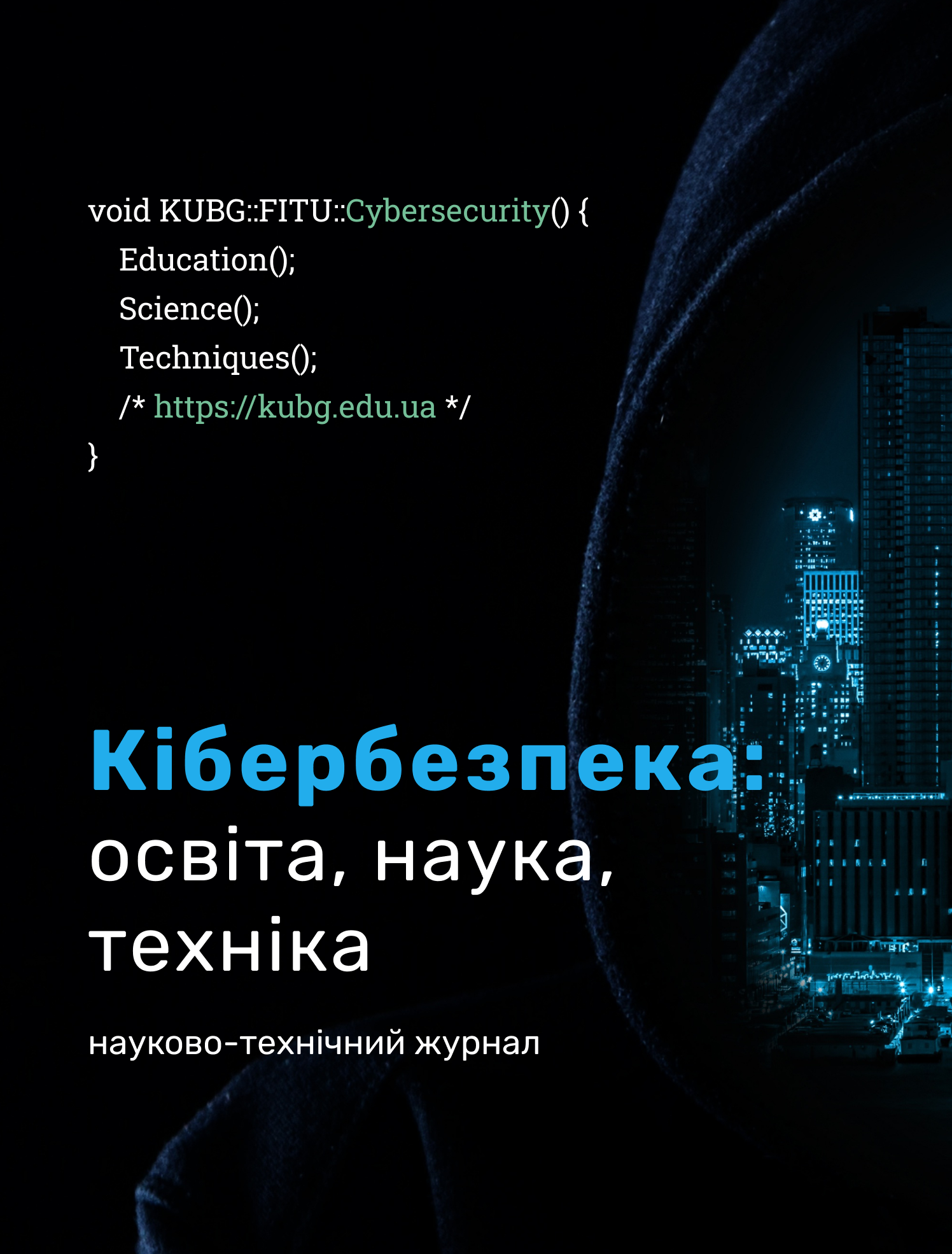STATISTICAL METHODS FOR PREDICTING PHISHING ATTACKS
DOI:
https://doi.org/10.28925/2663-4023.2024.23.5670Keywords:
forecasting; phishing attack; statistical methods; time series; automated information and communication system; trend; correlation-regression analysis.Abstract
The article proposes a methodology for predicting so-called phishing attacks, which are a common form of cybercrime, the number of which is growing every year, and the level of their harmful impact on the information systems of critical infrastructure objects is also increasing. To analyze trends and predict phishing attacks, we used statistical data published in scientific works of domestic and foreign researchers, as well as published by online publications of leading consulting companies working in the field of information security and cybersecurity. Statistical methods based on the use of time series, as one of the popular approaches used to predict various technological and economic processes, were chosen as tools for researching and predicting phishing attacks. This made it possible to analyze the types and patterns of phishing attacks that attackers use to disrupt the operation of software of information and communication systems and automated systems. Based on time series analysis, a trend model was built for the number of detected phishing attacks for the period 2020–2023. A calculation was made of the predicted number of phishing attacks for 16 quarters of 2020–2023, as well as the estimated forecast of the occurrence of these attacks for four quarters of 2024. To improve the forecast, a coefficient taking into account the seasonality factor was calculated and a correlation and regression analysis of the impact of phishing attacks on the total number of attacks detected during 2020–2023 was performed. Calculations have been performed, indicating that the discrepancies in the predicted values are not significant; the results presented allow us to select the optimal strategy for identifying, predicting and eliminating computer attacks related to phishing. Based on the time series model and the calculations obtained, it was concluded that statistical forecasting methods make it possible to build a forecast of phishing attacks, provide in the future the opportunity to develop and formulate methods for countering these attacks, and plan measures to increase the level of security of information resources.
Downloads
References
Sokolov, V., & Skladannyi, P. (2023). Methodology for Assessing Comprehensive Damages from an Information Security Incident. Electronic Professional Scientific Edition “Cybersecurity: Education, Science, Technique”, 1(21), 99–120. https://doi.org/10.28925/2663-4023.2023.21.99120
Kyrychok, R., et al. (2021). Rules For The Implementation Of Exploits During An Active Analysis Of The Corporate Networks` Security Based On A Fuzzy Assessment Of The Quality Of The Vulnerability Validation Mechanism. Electronic Professional Scientific Edition «Cybersecurity: Education, Science, Technique», 2(14), 148–157. https://doi.org/10.28925/2663-4023.2021.14.148157
Shevchenko, S., et al. (2022). Insiders and Insider Information: Essence, Threats, Activities and Legal Responsibility. Electronic Professional Scientific Edition “Cybersecurity: Education, Science, Technique”, 3(15), 175–185. https://doi.org/10.28925/2663-4023.2022.15.175185
Romaniuk, O., Skladannyi, P., & Shevchenko, S. (2022). Comparative Analysis of Solutions to Provide Control and Management of Privileged Access in the it Environment. Electronic Professional Scientific Edition “Cybersecurity: Education, Science, Technique”, 4(16), 98–112. https://doi.org/10.28925/2663-4023.2022.16.98112
Hulak, H., et al. (2022). Vulnerabilities of Short Message Encryption in Mobile Information and Communication Systems of Critical Infrastructure Objects. Electronic Professional Scientific Edition “Cybersecurity: Education, Science, Technique”, 1(17), 145–158. https://doi.org/10.28925/2663-4023.2022.17.145158
War in Ukraine: the pulse of cyber defense. (2023). https://drive.google.com/drive/folders/1RjuBE_5Yznwnh1ELkppB94JCq3y17tTI7
Hrebennik, A., et al. (2020). Vyiavlennia ta Prognozuvannia Rivnia Zagroz Dlia Korporatyvnoi Kompiuternoi Merezhi. Technichni Nauky ta Technologii, 2(20), 175–184.
Sokol, P., & Gajdos, A. (2017) Prediction of Attacks Against Honeynet Based on Time Series Modeling. Applied Computational Intelligence and Mathematical Methods. CoMeSySo 2017, Advances in Intelligent Systems and Computing, 662. https://doi.org/10.1007/978-3-319-67621-0_33
Werner, G., Yang, S., & McConky, K. (2017). Time series forecasting of cyber attack intensity. Proceedings of the 12th Annual Conference on Cyber and Information Security Research, 18, 1–3. https://doi.org/10.1145/3064814.3064831
Tang, M., Alazab, M., & Luo, Y. (2016). Exploiting vulnerability disclosures: statistical framework and case study. Cybersecurity and Cyberforensics Conference. https://doi.org/10.1109/CCC.2016.10
Hus´ak, M., et al. (2021). Predictive Methods in Cyber Defense: Current Experience and Research Challenges. Future Generation Computer Systems, 115, 517–530.
Hyndman, J., & Athanasopoulos, G. (2021). Forecasting: principles and practice. OTexts.
Dolgikh, A., Baybuz, O. (2017). Overview of Modern Developments in Time Series Forecasting Using Hidden Markov Models. Actual Problems of Automation and Information Technologies, 21, 60–73.
Lakhno V., at al. (2023) Model of Strategy Analysis During the Dynamic Interaction of Phishing Attack Participants. Electronic Professional Scientific Edition “Cybersecurity: Education, Science, Technique”, 4(20), 124–138. https://doi.org/10.28925/2663-4023.2023.20.124141
Deineko. Zh., & Diana, D. (2015). Study of the Dynamics of Phishing Attacks Using Wavelet Analysis. Information Systems and Technologies IST-2018, 396–397.
Basit, A., et al. (2021). A comprehensive survey of AI-enabled phishing attacks detection techniques. Telecommun. Syst. 76, 139–154.
Mokhor, V., Tsurkan, O., Herasymov, R., Kruk, O., & Pokrovska, V. (2020). A Model for Analyzing the Vulnerability of Sociotechnical Systems to the Influences of Social Engineering. Electronic Professional Scientific Edition “Cybersecurity: Education, Science, Technique”, 4(8), 165–173. https://doi.org/10.28925/2663-4023.2020.8.165173
Cyber attacks 2022-2023: an overview of the biggest incidents and what awaits us in 2024. (2023). H-X. https://www.h-x.technology/ua/blog-ua/cyber-threats-forecast-2024-ua
State Intelligence Service: Statistics of cyber attacks for four months of the war. (2023). https://www.kmu.gov.ua/news/derzhspeczvyazku-statistika-kiberatak-za-chotiri-misyaci-vijni
Actual cyber threats: I quarter of 2023. (2023). Positive Technologies. https://www.ptsecurity.com/ru-ru/research/analytics/cybersecurity-threatscape-2023-q1
Information agency Interfax Ukraine. (2023). https://interfax.com.ua/news/telecom/943392.html
Phishing and targeted phishing: protection tips. (2019). TechRepublic. https://www.imena.ua/blog/phishing-and-target-phishing
Cohen, J., et al. (2013). Applied Multiple Regression/Correlation Analysis for the Behavioral Sciences. LEA Publishers.
Published
How to Cite
Issue
Section
License
Copyright (c) 2024 Юрій Добришин

This work is licensed under a Creative Commons Attribution-NonCommercial-ShareAlike 4.0 International License.




